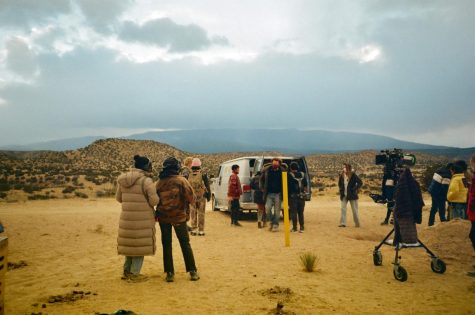Daniel Goldhaber’s “How to Blow Up a Pipeline,” adapted from the 2021 book of the same name, is concerned with one question: why can’t fun movies be radical?
Andreas Malm’s original nonfiction work argues that sabotage against anti-environmentalist infrastructure is an ethical form of climate activism. The movie revamps this theory into a fast-paced heist thriller, centering a group of environmental activists who set out to, aptly, blow up a pipeline.
Goldhaber was made aware of the book by producer Jordan Sjol, and felt the book’s environmentalist message was pressing. Goldhaber, Sjol, and Ariela Barer—who portrays one of the lead characters—cowrote the screenplay, and the movie was completed in 19 months from conception to distribution.
“There is no more urgent conversation to be had,” Goldhaber said in an interview with the Beacon. “We wanted to make a movie that felt urgent, and that dealt with urgent things urgently.”
The movie premiered at the 2022 Toronto International Film Festival in September, and was immediately picked up by distribution company NEON. After a buzzy festival run, it was released in U.S. theaters on April 7. In Greater Boston, it will show at the Coolidge Corner Theatre starting April 14.
Goldhaber’s previous directorial effort “Cam” brought psychological horror to the world of internet sex work, and explored the postmodern fear of losing control of your online persona. For “How to Blow Up a Pipeline,” he was faced with the unprecedented task of narrativizing an academic text into a crowd-pleaser.
“It was a natural extension of my process for the last several years, which has been taking ideas outside of the mainstream and figuring out how to tell them within a genre,” Goldhaber said. “In an era of IP adaptations, why not tap the theory department to mine ideas for films?”
He naturally gravitated towards the heist film genre, as the planning, process, and execution of pipeline demolition fit neatly into the framing of a classic “Ocean’s”-style caper.

The cast of characters in “How to Blow Up a Pipeline”
“There’s a political legacy of heist films that we were tapping into,” he said. “Heist movies for a long time had been a genre by which filmmakers can explore inequality in our world. Here, the inequality being explored is climate inequality.”
The narrative follows a crew of eight environmental activists who, all for different reasons, have chosen to join forces and endeavor to blow up a pipeline. Much of the movie is concerned with the handling and production of explosives, from which Goldhaber demonstrates his precise control of audience tension.
In one scene, the crew strenuously attempts to attach an explosive barrel to the eponymous pipeline by hoisting it with a strap. The strap is fraying, as one of the members points out; another yells to keep going. Amid the rising soundtrack and escalating grunting, we naively hope this minor task gets accomplished. Then the fray frays, the barrel barrels, and the crew recoils. Cut to: title card. No one in the audience is breathing.
This moment—and other such inconvenient cutaways—constitute the movie’s best. Whereas conventional movie language dictates that explosions should conclude a sequence of events, Goldhaber subversively uses them to start off flashbacks into characters’ pasts, before cutting back to Schrödinger’s blast injury.
The non-linear structure of the movie opens by launching us into the heist with a complete crew, and dives into character backgrounds only when something goes wrong. This ideology-first storytelling results in sudden bursts of empathy, where amid the chaos the audience is forced to parse the lives each character has put at stake in pursuit of a common goal.
“All the lived experience that backs up the characters is present with them,” Goldhaber said. “It’s with them during the action, and it informs their political action in a way that is really interesting.”
In classic heist film manner, each character generally adheres to archetype markers: single-mindedly ideologic ringleader Xochitl; belligerent, would-blow-up-for-the-cause Michael; conservative-coded cowboy Dwayne in it to get the pipeline off his property.
The initial straightforwardness in characterization is remedied by strong performances and compelling flashbacks, if only ever framing the characters in relation to the titular act of sabotage. But like in any good heist movie, human interest is found in watching the different types clash-then-combine heads.
“We wanted to make a film about a cross-section of the American climate movement, which is something that heist films do well,” Goldhaber said. “They show you a real array of the social problems of the time.”

Behind-the-scenes on “How to Blow Up a Pipeline”
The characters and their backgrounds are left elliptical because the movie is an argument at its core, a fact that is never under pretense. For better or for worse, the scope of the movie is confined to the events of the environmental heist, and everything is in service of justifying the act of anti-environmental sabotage.
Characters engage in overt conversations about the ethical and moral ramifications of property destruction. In one on-the-nose detail, a character is shown to be reading Malm’s original book—implied to have sparked the idea for the fictional plan of sabotage.
But for these theoretical ideas to gain broad appeal, the movie’s visual language had to be wide-rangingly sensational. The movie keeps pace with the highest-tempo of contemporary action cinema, and the actual execution of the heist is filled with twists and explosions that are, in one word, exhilarating.
“We absolutely want to use the tools of mainstream filmmakers to expose audiences to ideas that are otherwise relegated to the fringe,” Goldhaber said. “If we want leftism to be something not confined to the fringe, we have to engage in media and messaging tactics that are not fringe tactics.”
So the movie is unabashedly propagandistic, but to the extent that all popular media is. Goldhaber argues that the intellectual property–based franchises that have dominated the mainstream movie sphere for the past ten years are equally guilty of messaging, which have become acceptable only due to their ubiquity.
“‘The Lego Movie’ was the first of these adaptations I noticed,” he said. “The purposes behind it are a bit nefarious. It’s like a full-length ad that we call a film.”
Whether “How to Blow Up a Pipeline” found the right balance of didacticism and sensationalism may be up for debate, but its lack of ambiguity in message or pretense in intention can only be seen as admirable.
“There’s this deeply felt thing on the left that to be accessible you have to be reductive, that you have to damage the integrity of the ideas if anyone is to understand what you’re saying,” Goldhaber said. “But I don’t think that’s true. Ultimately, it’s the same balancing act that you strike with any movie.”